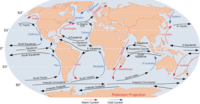
Photo from wikipedia
AbstractStrong upwelling events inshore of the Agulhas Current close to 33.5°S are investigated. These events are important to the exchange of shelf and slope waters, potentially enhancing primary productivity and… Click to show full abstract
AbstractStrong upwelling events inshore of the Agulhas Current close to 33.5°S are investigated. These events are important to the exchange of shelf and slope waters, potentially enhancing primary productivity and advecting larvae offshore. Using hydrographic observations, this study shows that a wind-driven upwelling event and a current-driven upwelling event can each advect central waters more than 130 m upward, resulting in a maximum 9°C cooling at 50-m depth over the continental shelf and surface cooling greater than 4°C. The authors use satellite data to assess the frequency and forcing mechanisms of similar cold events from January 2003 through December 2011, defining cold events as days when the sea surface temperature (SST) anomaly is significantly correlated with a local current or wind forcing. The authors identify 47 events with an average length of 2.2 days and SST anomaly of −1.6°C, corresponding to an average 13 days of surface cold events along the Agulhas Current front per year. This study...
Journal Title: Journal of Physical Oceanography
Year Published: 2017
Link to full text (if available)
Share on Social Media: Sign Up to like & get
recommendations!